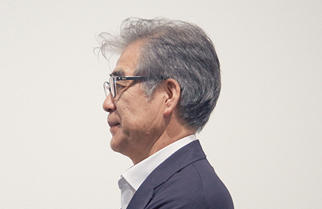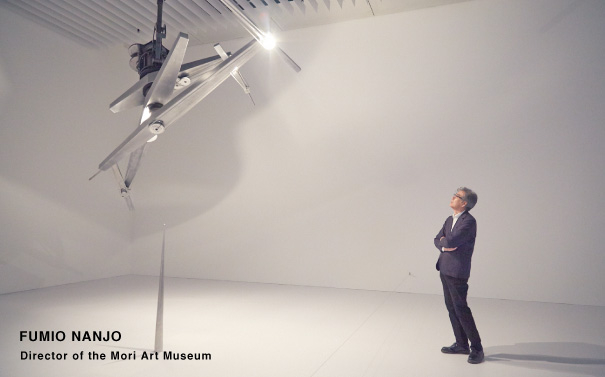
71 Fumio Nanjo(Director of the Mori Art Museum)
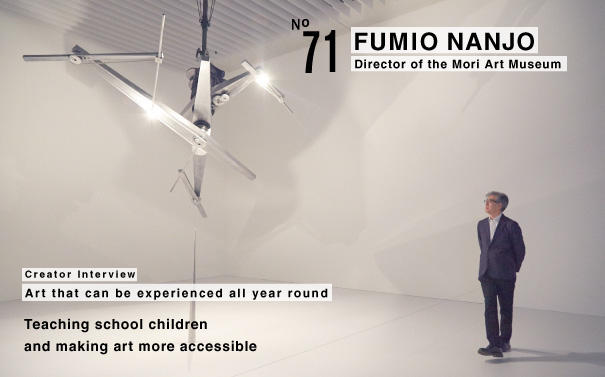
For many years, Fumio Nanjo, director of Mori Art Museum, has overseen various large-scale public art and corporate art projects, and has served as curator and director at numerous art festivals and events. During the first half of the interview, Nanjo talked about Roppongi Art Night and the steps being taken at Mori Art Museum. In the latter half, we asked him about art festivals held in the regions and about his thoughts on the future of art museums.
Doing things that can be visually perceived
Art museums have so far been institutions in box-like buildings, and until now, everything was done indoors. But if art museums are going to take on a wider role and become more like art centers, I think we need to move art out into the streets. At the Mori Art Museum, we often use the phrase "art and life" because we believe that the ideal is for art is to be blended into our everyday lives.
There are various ways to do this such as holding events like Roppongi Art Night and increasing the number of public artworks as much as possible. A few years ago, a new work of public art was installed at Mohri Garden to mark the 10th anniversary of Roppongi Hills. Instead of thinking that everything is complete when a town has been built and the artwork has been put in place, we need to continue developing a town.
If you really wish to make Roppongi into an artistic place, you need to do all kinds of things that can be visually perceived. In Cuba, live music is played in all the cafes just like in the movie "Buena Vista Social Club." It makes me wish we could have the equivalent of that in art.
Roppongi Art Night for every night of the year
Nowadays, community-based art is often used to promote regions. If art events and workshops were constantly held in Roppongi, it would be like having Roppongi Art Night all year round. That would definitely make Ropppongi a different place, setting it apart from other areas in Tokyo.
At Roppongi Hills, a Kids' Workshop is held during the summer holidays. The tenants of Roppongi Hills, and many organizations and companies collaborate to offer a variety of programs. Mori Art Museum also corporates in some of the programs.

Roppongi Hills Kids' Workshop
Workshops held at Roppongi Hills for various activities such as crafts, cooking and experiencing jobs. A workshop born from a joint research project by Mori Building and MIT Media Lab is the "Mirai Summer Camp" which allows children to learn about the latest technology. The photo is of the "Summer Night Museum" workshop held by Mori Art Museum and Roppongi Astronomy Club.
Of course, it is an expense, but it is not very big when you consider how it contributes to the branding of Roppongi. Creativity is lost when management focuses solely on cutting costs. I think we need to look at things from a wider perspective and develop towns by using design and art to create a brand image.
The changing definition of art
For Roppongi Art Night 2016, the theme I set was "Transforming Roppongi into a big playground." I wanted to send out the message that it's an event everyone can participate in. And at such an event, art that is easy to understand is as important as highbrow art. These days, it's become difficult to define what art is, hasn't it? The boundaries of art have become so blurry.
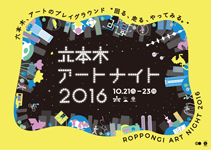
Roppongi Art Night 2016
An art festival in Roppongi that started in 2009 and which marked its seventh year this year. Roppongi Art Night 2016 was held for three days from Oct. 21 (Fri) -23 (Sat). The artist for the main program was Kohei Nawa. Visitors enjoyed a wide variety of innovative art installations and performances.
I think we should try to maintain the authenticity of art but not be concerned about the edges getting a bit eroded. People sometimes complain that the Japanese language is not being used properly, but it's natural for languages to change with the times. It's the same with art. Throughout the history of art, there have been changes, and we should accept those changes.
While increasing art activities, we must also try to let everyone know about them. It's important to make efforts in imparting information - putting data on the Internet and giving careful explanations. People ignore things when they have no knowledge of them or don't understand their meaning. There are around 20 million visitors each year to Roppongi Hills but only a fraction of them come up to Mori Art Museum and Mori Arts Center Gallery at the top of the Mori Tower building. There are even some people who work in the offices in the building and don't know that there is an art museum above them. (laughs)

Town development is about creating a culture
Besides Mori Art Museum, there are many other important art museums in Roppongi, but those facilities alone are not enough. We need more art galleries, more public art and more museum shops, more night events and more workshops where children can have fun. There should be a gathering of different functions and elements so that the level of culture surrounding art is lifted. The ideal is to have art take root in the streets rather than having a place with art on the surface.
People tend to think that town development means constructing buildings and attracting tenants, but it is actually about creating a culture for visitors and for the people who live and work there. Art and design are very important in this aspect because they help people to connect with each other. When events and workshops are held, parents and children and visitors from faraway places gather in one place. By enjoying art and workshops together, they come to understand each other. Doing creative activities has that effect.
Art museums should ideally be open 24 hours a day
Developing a town takes a very long time, but nowadays when I see schoolteachers bringing their students to our museum, I feel that our activities are having an influence. The hours spent at schools in Japan on music and art education are being increasingly reduced, and I believe that art museums need to teach children about art.
There are art museums in every prefecture, and I think that staff in those museums should be dispatched to the elementary schools to give art lessons. In the world of theater, they already have that system: children's theater troupes tour schools around the country. We used to send staff to schools on request, but recently, we have become unable to do that due to shortage of staff...
The unique thing about Roppongi is that the art museums here are kept open at night. Mori Art Museum is open until 10.p.m. except on Tuesdays; it allows people to have dinner and then visit the museum. This kind of lifestyle would be difficult in a place where there are few restaurants. You could say that we are taking advantage of the characteristics of Roppongi.
As long as there are visitors, art museums should ideally be kept open 24 hours a day. Roppongi Art Night is a model case for that. If we could create an environment where young people keep coming to art museums until late at night, establishments will stay open and do good business. We once applied for permission to create a special art zone. If the strict regulations were removed, perhaps Roppongi Art Night could be held several times a year. Although I think the staff, including me, would all die. (laughs)
A cultural version of the World Economic Forum
This is a change in topic, but after World War II, Japan thrived on an economic system based on mass production. That system has now collapsed and what we are left with are the creative businesses such as IT and design and art. We have to think about what we are going to do.
That is why the Innovative City Forum was launched in 2013. We initially referred to it as "Creative Davos" when talking among ourselves, because we were looking at it as a creative version of the World Economic Forum meeting in Davos. We wanted to have a meeting that would be so interesting that people from all over the world would want to spend their own money to come and hear about the latest topics and trends.

Innovative City Forum
A convention launched in October 2013 to hold discussions on the theme of "Designing the future for global cities and lifestyles." Talks are held by experts in the three categories of "leading-edge technology", "city development" and "art and creativity". In 2016, the event was held Oct.19 (Wed) -20 (Thurs) at Toranomon Hills Forum.
Photo courtesy of Mori Building Co., Ltd.
Japan needs to be the creative hub of Asia, attracting the best creative ideas. If we keep holding this meeting for 10 years, the world will begin to think of Japan as a creative hub - that is the strategy I have in mind.

The main difference between art museums and art festivals
Art festivals have recently come to be held in many places around Japan. Can you guess what the main difference between art festivals and art museums is? It's the exhibition space. Art museums are white square boxes in which you can place almost anything. Because they're dry, inorganic spaces, they make anything look good. (laughs) But at art festivals held in the regions, such facilities are almost nonexistent and people have to start from scratch.
They have to decide where to place the art, which means that they need to use a lot of imagination to design everything. What they are doing is literally inserting art into everyday places. That is the biggest and most interesting difference from art museums. It's essentially the blending of art into everyday life that I talked about earlier.
The three types of art at Kenpoku Art 2016
I'm currently serving as general director of Kenpoku Art 2016, which is an art festival made up of basically three types of art. One is art that has impact when placed outdoors in nature, the second is new art using technology, and the third is art made in collaboration with the local community.
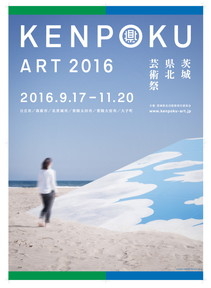
Kenpoku Art
The largest art festival held in Japan in terms of area capacity. Kenpoku Art 2016 was held Sept. 17 (Sat) - Nov. 20 (Sun). More than a hundred works by around 80 artists from Japan and abroad were displayed. Among them were works by teamLab and Yoichi Ochiai. The event was held in six towns and cities in the northern part of Ibaraki Prefecture.
Among the big-scale works is Hitachi station whose design was overseen by Kazuyo Sejima. There is a 300-meter glass corridor above the rail lines. At the end is a glass-paned observation deck from which you can look down at the sea. The walls of the corridor have been covered with color sheets by Daniel Buren, and have tremendous impact. There is also a work by Choi Jeong Hwa which consists of tapes hanging from a 600-meter suspension bridge, as well as a painting by Ilya & Emilia Kabakov which lies on the beach as if thrust there. There are so many dynamic works.
As for technology type art, there is the music "Synechococcus" which Etsuko Yakushimaru composed based on the gene sequence of alga, and which is the theme song for Kenpoku Art. It is art made from the latest biotechnology; the music was put back into the DNA of alga to go on for eternity.
As for community-based art, an artist called Saki Chikaraishi has spent two months covering things in the shopping area in front of Hitachi-taga station with knitting. There's also a work that is like an event: a sitting room will suddenly be set up in the middle of the streets and people will be invited to stop by.
The importance of philosophy in the advancement of science
Incidentally, my current interests are science and philosophy. Since I'm not very good at memorizing details, and can only grasp the gist of things, philosophy suits me. (laughs) Because philosophy is abstract.
I find AI (artificial intelligence) and biotechnology the most interesting genres in science as they will have a big influence on the future of humanity. Around 2035-2040, AI is expected to take over human society in a phenomenon referred to as "singularity." The important thing then would be philosophy or rather, ethics.
For example, if AI was told to remove things that are bad for the environment, people could get killed. Or there might be a situation when a car crash is about to occur, and a computer-controlled vehicle must decide in one second whether to bump into a car with three old people in it or into a car driven by one young person. It is impossible for anyone to make such decisions, isn't it? So ultimately, it comes down to philosophy, and the way people think about things; we need to know what really matters to us.
Biotechnology and our future
When you go to "The Universe and Art" exhibition at Mori Art Museum, you will learn that NASA is holding a design competition for housing on Mars. Virgin Galactic is predicting that within a few years, it will be able to operate spaceflights for 20 million yen. More than 600 people have already signed up.
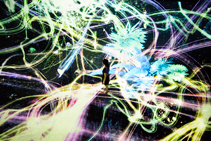
The Universe and Art - Princess Kaguya, Leonardo da Vinci, teamLab
An exhibition of around 200 items from various genres including handwritten notes on astronomy by Leonardo Da Vinci which will be shown in Japan for the first time. Also on display will be meteorites, fossils, historic astronomical manuscripts, mandalas, the latest in space development and a new art installation by teamLab. The exhibition will be on until Jan. 9 (Mon. national holiday) 2017 at the Mori Art Museum.
The image is of "Crows are Chased and the Chasing Crows are Destined to be Chased as well, Blossoming on Collision - Light in Space" made in 2016 by teamLab. It is an interactive digital installation with the performance lasting 4 minutes 20 seconds.
Sound effects by Hideaki Takahashi.
By the way, it takes two years to reach Mars and people will be exposed to radiation during that time. Unless something is done to make the human body resilient to radiation, long trips into space will be impossible. Water bears (tardigrades) do not die when exposed to radiation, and some researchers are studying the possibility of inserting their DNA into humans. Biotechnology is relevant for space travel and for many other things related to our future.
Museums of the future
There's one last thing I'd like to mention concerning the future. I think that museums will come to be divided into various types. One type of museum will be like the art museums we have now - laboratory-like places where new experiments can be made. Another type of museum will be like the Benesse House Museum in Naoshima -facilities built in special locations and which are tourist destinations.
There may also be museums that are integrated with towns. In Aomori, there is the Towada Art Center which is made up of cube-shaped buildings that are each connected by a corridor. The art museum could become bigger if the same cube-shaped buildings were to be built in the vacant lots in the town. It could become one huge art museum that is completely unified with the town, consisting of small galleries; such art museums might be built in the future.
I also foresee art museums that are like entertainment-oriented theme parks. Perhaps teamLab might display about 30 pieces of artwork in a tent. It would be like Disneyland, but if the artists say "We are artists and this is art", then a theme park will become an art museum.
In the future, there might even be museums which are specifically open for certain people and which refuse first-time visitors. In Ehime Prefecture, there is a small uninhabited island called Toyoshima; people go all the way to this island by boat just to see one single work by Gerhard Richter which is displayed in a building there.
What makes people go to art museums
An acquaintance of mine who is a designer suddenly decided to go to Paris. He said, "Japan has a tradition of wrapping things. I will start a business to provide gift-wrapping services." I told him, "The French will not pay money for that kind of thing." After a while, I made a visit to his shop. It was a small place, but its walls were paneled with hinoki (cypress) wood and there was a flower arrangement on the "tokonoma" alcove. A member of staff wearing a kimono whisked a bowl of "matcha" green tea for me.
Two years have passed since then, and the shop is still there, even though there are no customers. He told me that as soon as he opened the establishment, project managers from well-known brands instantly came to him, and he is now a consultant for 10 companies. Nowadays, brands need to do more than just sell goods. They need to think about the overall experience of buying - how the customer makes the choice to buy a product and what happens after the purchase. And so people are seeking his advice.
Naoshima, which I mentioned earlier, is a place that has not only art, but also the sea and nature, a building made by a famous architect and a unique art experience. Visitors can enjoy barbeque in the evening, and stay in a nice hotel. People pay for all of those experiences put together.
It's said that we live in times where art is in demand, but people are not seeking just art itself. They are seeking experiences that they normally don't have. Art is probably the most effective way to fulfill those desires.
Editor's thoughts
Nanjo-san said that an astronaut he talked to said these following words: "Although it probably won't happen in our time, there will definitely come a time when the earth will become inhabitable. That is why we are making preparations." In order to see what kind of preparations are being made, please visit "The Universe and Art" exhibition.
(edit_kentaro inoue)




